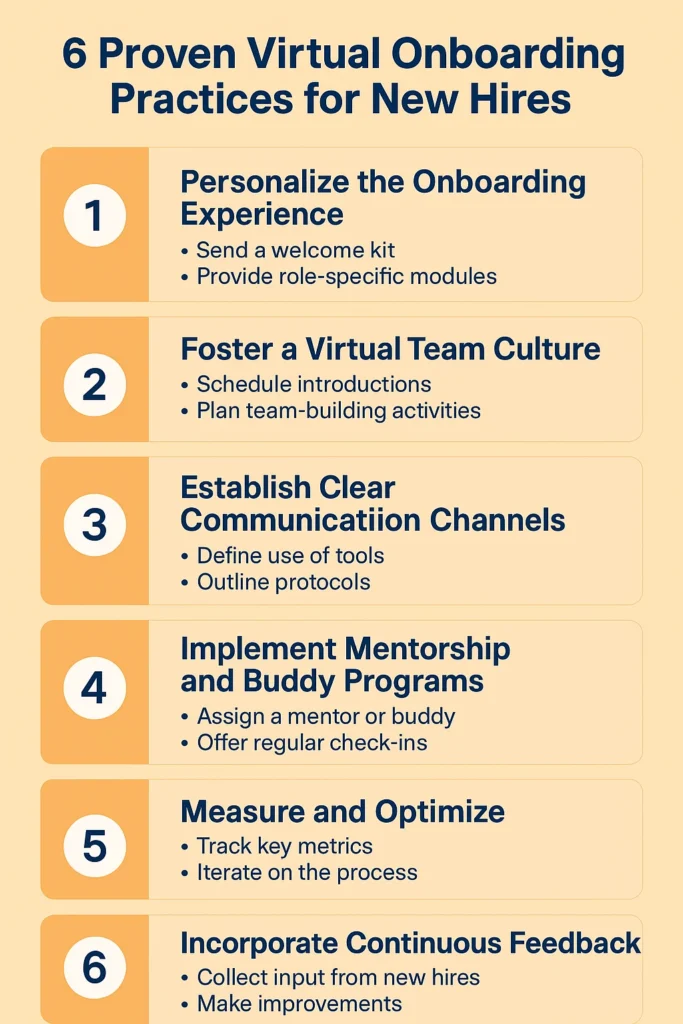The first day on the job used to be an in-person event: stepping into an office full of new people, smiling, and receiving a box of welcome treats. For many employees now, that first day happens through the light of a laptop screen.
The share of employees working remotely worldwide increased significantly in recent years, rising from 20% in 2020 to 28% by 2023. Remote work is no longer Plan B. For many, it is the plan.
But here’s the challenge: while meeting deadlines remotely works just fine, ensuring new hires feel connected to your company culture? That’s a whole different ball game. And that’s where virtual onboarding comes in. It’s a defining moment that can shape a new hire’s first impressions and their feelings about joining your organization.
Here are six virtual onboarding practices that can turn your process from ‘just paperwork’ into a welcoming experience that fosters loyalty, confidence and connection.
1. Personalize the Onboarding Experience from the Start
Imagine you are hosting a dinner party. A one-size-fits-all menu might feed your guests. But, a thoughtful spread that caters to individual tastes? That’s what makes people talk about it for weeks.
The same goes for onboarding remote employees. Skip the cookie-cutter checklist and instead:
- Send a personalised welcome kit that fits their role. Think branded gear, curated resources, maybe even a handwritten note.
- Share pre-recorded welcome videos from their future teammates or leadership.
- Give them role-specific onboarding modules that help them hit the ground running.
Why? Because their ‘Day One’ is your first big chance to whisper (or shout), ‘You matter here’.
2. Foster a Virtual Team Culture with Structured Introductions
Remember your first day in school? When the teacher made everyone share their name and one fun fact? As clichéd as it was, it worked. You started piecing together the human side of your classmates.
Structured introductions do the same for remote teams.
- Create a schedule where employees from different departments can meet virtually.
- Let them introduce themselves. Let them explain their roles.
These simple virtual team-building exercises give new hires the opportunity to see the bigger picture, how every piece of the puzzle fits into the company’s overall structure.
Go beyond the basic introductions.
- Think about incorporating ice-breaker activities or team-building games.
- Consider informal catch-ups where new hires can get to know their colleagues on a more personal level.
These interactions humanize the remote environment. Because when you know the person behind the email handle, collaboration feels less like a transaction and more like a shared mission.

3. Establish Clear Communication Channels Early On
In remote work, even a small miscommunication can create confusion and derail progress. That’s why having clear, reliable channels is essential for a smooth and effective virtual onboarding experience.
But listing platforms isn’t enough. New hires need to know the how and why. Is Slack for quick check-ins? Is Teams for project discussions? Clear guidance on the purpose of each tool helps them navigate the virtual workspace with confidence.
Additionally, establish who they should update on tasks, how to approach colleagues for collaboration, and what the expected response times are. Defining these protocols early reduces uncertainty and builds trust, helping remote employees feel confident navigating their virtual environment.
4. Implement Mentorship and Buddy Programs
In a physical office, you could lean over and whisper, ‘Hey, how do we submit expenses?’ or ‘What’s the unwritten rule about taking Friday off early?’ In remote work, the answers to these aren’t as easy to come by.
Mentors and buddies come in handy here. Assign each new hire to someone who
- Offers a safe space for questions, big or small.
- Conducts regular check-ins to ensure no one is silently struggling.
Be careful when selecting mentors. They need to understand the company culture inside out. They should embody your company’s values and be able to share insights into both the big picture and the day-to-day operations.
5. Measure and Optimize the Virtual Onboarding Experience
Onboarding isn’t ‘set it and forget it.’ It’s an ongoing process, like tending a garden. You plant seeds, track growth, and prune what’s not thriving.
The first 90 days, especially, are make-or-break. Researchers consistently find that remote employees who have positive experiences during these initial months are 10 times more likely to stay long-term.
So, how do you achieve that? Track the right metrics.
- Time to productivity.
- New hire retention/turnover rate.
- Onboarding experience score.
These numbers give you a clear picture of how well your onboarding process is working, and where it needs improvement.
6. Incorporate Continuous Feedback and Improvement
Regularly update your processes based on feedback. What helped new hires feel seen? What felt clunky? These insights should feed directly into your program.
Remember: people’s needs evolve as the workplace changes. Collect feedback, adapt, and improve. It’s the secret sauce to a smooth, successful process.
- Solicit Feedback: After each phase (first week, first month), ask your new hires for their thoughts. Was the training helpful? Were the tools easy to use? What could be better?
- Act on Insights: Listen closely and put that feedback to work. Identify pain points and adjust communication, training, or even team interactions. Make sure it’s working for everyone.
- Continuous Evolution: Stay on top of workplace trends and evolving employee expectations. Regular updates make sure your process stays fresh and relevant.
In this way, you can guarantee an efficient onboarding experience for your remote employees.
And here’s the kicker: various studies show that effective onboarding boosts retention by 82%.
By constantly optimizing based on feedback, you show your new hires that their success matters. It’s about proving you’re invested in their journey from Day One.
To Conclude: Go Beyond the Basics
Your virtual onboarding process sets the stage for a new hire’s success, and ultimately, their longevity with the company. It shapes their entire perception of the company and their role within it.
Consider integrating tools such as interactive onboarding platforms, virtual reality (VR) for immersive experiences, or even gamified learning modules. These can help keep your new hires excited and engaged.
Ready to elevate your onboarding experience?
Let’s collaborate on designing a program that sparks engagement from day one.
FAQs
An effective virtual onboarding process includes personalized welcome packages, clear communication protocols, introductions to the team and company culture, and structured learning opportunities. It’s about creating engagement, fostering connections, and setting new hires up for success in their role. Regular feedback and mentor support also play crucial roles in ensuring long-term success.
Personalizing remote onboarding means tailoring the experience to each new hire’s role, team, and department. Start with a customized welcome package, including role-specific training materials, personalized video messages from team members, and introductions to key colleagues. This helps new hires feel seen and valued, even from afar.
Clear communication minimises confusion and boosts productivity. By setting clear expectations about when and how to use communication tools, you ensure that remote employees feel confident navigating their new virtual environment.
Mentorship and buddy programs provide a critical support system for new employees. These programs offer new hires a go-to person for guidance, questions, and social connection. A well-assigned mentor helps ease the transition, making the remote employee feel part of the team and the company culture, while also providing valuable insights into company processes.
Measuring success involves tracking metrics like time to productivity, engagement levels, and employee satisfaction. Regular feedback sessions with new hires help pinpoint areas for improvement and ensure the virtual onboarding process remains relevant and effective.



